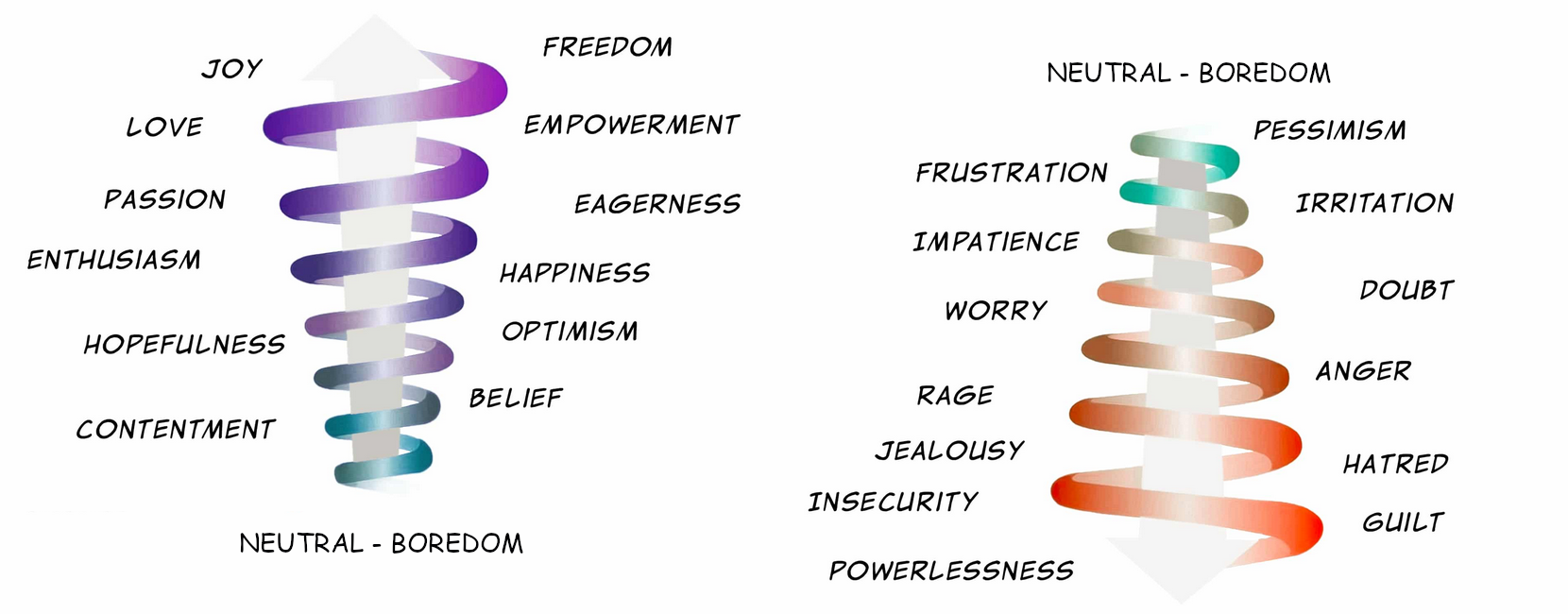Creation Series: A guide to raising your energy, mindset and outlook on life (Part 2)
You get out of negativity, HOORAY! Now what? How do we get into higher more positive energy from this neutral place?

This post is free for the public with members only worksheets.
This is part two in the Creation Series on The secrets to living your best life. While you could definitely benefit greatly from raising your vibration/mindset/outlook from this article, it is possible your existing negative energy could hold you back or bring you straight back down every time. To clear this negative energy, read and try the exercises from Part One - The secrets to living a life well lived.
Once we have achieved neutral on a more consistent basis, it's time to congratulate yourself as neutral or ground zero is not celebrated enough. It's understandable that there is an impatience to move higher, however, this celebration or appreciation is a large part of moving into a higher mindset, outlook or awareness. So, celebrate and appreciate how far you've come already!
YOU get appreciation, and YOU get appreciation!

Firstly, let's touch on a minor difference that can have a big impact on this exercise working or being more of a waste of time, and that is the difference between gratitude and appreciation. While many use these two interchangeably, the underlying feeling or meaning is a little different.
Gratitude often comes from looking at a more negative situation or lack. I'm grateful for my house/apartment (or, I'm grateful that I'm not homeless or in that old run-down place). I'm grateful for this delicious food (or, I'm grateful that I'm not hungry or having bland food again).
When we change the word to appreciate and associate a new feeling or new starting point to it, the process becomes much more powerful. I really appreciate this Butter Chicken. Notice how it's not coming from a lack of Butter Chicken. Likewise, notice how it is more specific (rather than just "delicious food") which also helps to avoid the feeling of a lack of something.
Appreciation moves you from a neutral or a lightly negative place into contentment, love or higher which is a much happier place to be. Simple appreciation exercises can move you from a funk into a much better place. For example, if you are in a funk about your job, make an appreciation list of the aspects you really appreciate about your job. Getting some money ought to be appreciated, for instance. Do you have work friends or customers that can make you smile? Is the work fairly easy for you (leaving your creativity free to roam)? List every possible aspect to appreciate and really feel the appreciation for these aspects. This can train your thinking into noticing and appreciating moments and people as they come to you as opposed to only in your journaling time.
This List of Appreciation exercise can be used on any topic or area of life you choose. For example, if you have a person that is particularly troublesome for you, write a list of appreciation for them. If you have a car that keeps breaking down, list all the good things and opportunities it has brought you. Dig into the past for more appreciation to add to your lists as you've possibly never appreciated these aspects before.
As you may have guessed, this won't necessarily change your situation immediately (although it's possible). What it will do is raise your own vibration or mood when thinking or being in that situation, or with that person or object. When we're in appreciation mode, we're well above neutral (and fairly often have come from a slightly negative perspective) meaning we're beginning to attract more positive events into our lives.
Even if you do no other exercise than Lists of Appreciation every morning, your vibration will begin to rise significantly as will your mood and attitude each and every day.
Mountain Climbing

Let's look at an example person for this exercise and follow along with your own journaling or meditation.
Sally finds herself in a fairly neutral or appreciative state about most things in her life, except for her weight. Sally loves and appreciates her food, but not how she looks in the mirror. When we aren't able to love our own image in the mirror, it can be quite difficult to raise our vibration or mood in other areas of our life.
I'd like to put a quick disclaimer at this point. This example is not about body shaming our fictional Sally. It's about how Sally feels about her own image. Because she's fictional, we get to hear about her true, authentic thoughts. People, in general, can have excess weight and have only positive and appreciative thoughts about their body and image. Suffice to say, this article is not about health or ideal weights, but rather, about one's own thoughts or beliefs about their own body or image.
Getting back to Sally who's unhappy about her image in the mirror. This tends to make Sally wear larger, ill-fitting clothing because she wants to hide parts of herself. Sure Sally could get advice on clothing or try a new diet, but ultimately using force or will-power alone will fail because the mindset itself is unchanged.
Let's assume Sally has worked on her negative beliefs and perspectives (from Part 1 - The secrets to living a life well lived) or even seen a therapist about past trauma, and is still not happy on the topic of body image. She can try the Mountain Climbing activity.
To go from a negative body image to loving and appreciating every part is much too big a step and too unbelievable for Sally. In order to climb a mountain, we need to focus on one step at a time making sure our footing doesn't slip (and we fall back down). Unlike real mountain climbing, there's no risk of injury in this thought/journaling exercise.
Firstly, Sally thinks about the parts of her body or bodily health that she can appreciate now. It needs to be something she already believes or is not too big a leap. Maybe she loves her strong legs, the size of her chest or that her body is fairly healthy and takes her all the places she wants to go. This step is nothing crazy, big or anywhere near the top of the mountain, but it's a single step in the right direction.
Now that she has both feet on the mountain and moving in the right direction, many paths could open up and some might not lead in the direction that Sally wants to go. Sally needs to spend a little time defining what is at the other end of her journey, in other words, what is at the peak of her mountain? Perhaps she wants a wardrobe that she can be extremely proud and confident in. Or perhaps she does want to lose weight, get fit or shapely. For this example, let's assume she wants to lose weight while remaining healthy with a good amount of energy.
She could shift her focus to be broader or more general and get a better foothold on the mountain, for instance, about all the healthy food she could eat, or the inspirational path of a celebrity to give her focus on her own path. She tries thinking how she can improve her body image herself (or believing in herself). She thinks of how other inspirational figures have lost weight and how she's sure that she could do it too.
The point of the exercise is to believe every step and to get as high as possible each time you do the activity. By shifting your focus or attitude on this one negative thought pattern in your life, it brings new opportunities, new inspiration and ideas that otherwise couldn't reach you because the negative energy deflects them away.
Write it out

Occasionally, we have used the word vibration without explaining fully what vibration actually is. Each emotion that we feel can be associated with a certain frequency of vibration. Much like the pitch of a sound wave has a frequency, so do our emotions.

This scale was devloped by David R Hawkins and called the Map of Consciousness. Hawkins laid out the entire spectrum of consciousness or energentic frequency from the lowest energy of shame to the highest called enlightenment. We know this instinctively and use different words to describe this scale. We associate heaviness, density and dark colours to the lower end of the scale and lighter, breezy words to the higher end.
Sometimes a new situation (i.e. not a belief from the past) has us heading down this scale towards the lower end. That's OK, you think, I have tools to fix my beliefs, but this is a new situation not a belief picked up from the past. It's not a belief to debug and the Mountain Climbing activity isn't working because you are too far down the scale in frustration, anger or even hopelessness. What can help in these newer situations is to write it out.
Taking a blank or lined piece of paper, start from where you are and write out why you feel you are in a certain emotion or how it feels. Not as justification but really feeling yourself being in this emotion. It can be what people call a rant, especially when it's about the anger level of emotion. Rant away (on paper) until all that level of emotion is out of your system.
When you're done with that level, look for a word that's a step above. Don't jump too far, just a little step. From anger, for example, you could move to worry or doubt and continue to write out what frustrates you about this situation. Again write until you have no more frustration and look for the next step up to write about.
Continue writing about each emotion until you can no longer feel or believe the feeling. When coming from a very low position you might not get into the positive before stopping and this is OK. To shift from very negative to slightly negative is still quite a big shift to be applauded. Try again tomorrow remembering to always start from where you actually are (not where you'd like to be). The writing is only for you, so you can be honest.
Each time you repeat this process on the same topic you might be able to get a little higher, you might not for a while and that's OK too. Be happy with any step up the emotional scale because it is truly worthy of a standing ovation to shift your own vibration.
If you're like most people, you probably don't want others to read this literary work. Feel free to shred, burn, tear or otherwise render it unreadable which can also be cathartic to physically clear the negativity.
There you have it, three new ways to raise your mood, emotion and vibration which will in turn raise the vibration of those around you and attract better events and situations into your life.
Which will you try first?
Stay tuned for further climing up the emotional scale to happiness, joy and well-being in an upcoming post about about happiness and well-being. So, if you're interested in finding out when that's released and have access to the worksheets, join Future Forward for free below.
Belinda Allan is an education advisor who is dedicated to empowering lifelong learners. By exploring the intersection of technology, personal development and learning futures, Belinda uses her expertise in education, IT and AI to guide individuals in creating the course or training program of their dreams. With a focus on how AI can drive productivity and well-being in the ever-changing landscape of education and work, Belinda will help you unlock your full potential.
Unlock your potential for happiness and success with the Learning Lounge newsletter - sign up now to receive tips and insights on how to find more joy in your day, as well as expert advice on leveraging technology and AI to achieve your goals.
Worksheets
Sign up or login to see the free worksheets for these activities.

